11 Species of Woodpeckers in Oklahoma (with Pictures)
Last Updated on
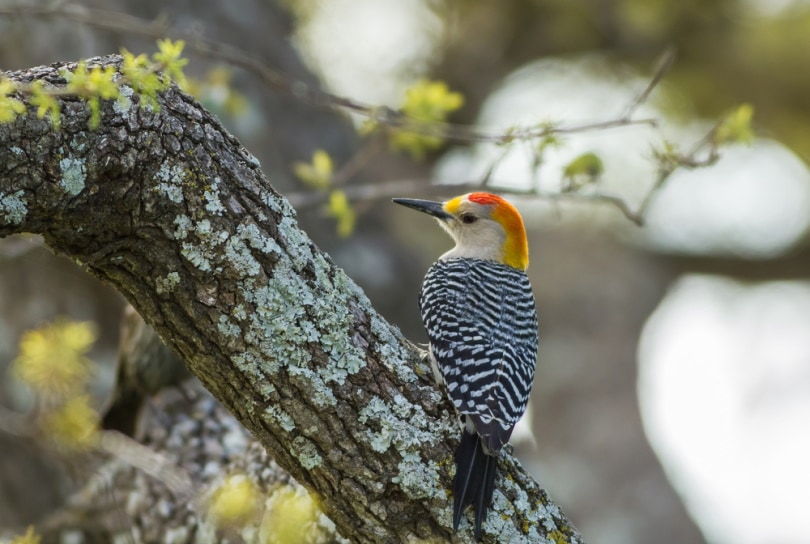
The state of Oklahoma covers an area of over 69, 899 square miles. While mostly made up of the plains, there are some dense forests found in the eastern portion of the state. Oklahoma has a mild climate and is centrally located, making it a prime habitat for wildlife.
Here, we are going to go over the 11 different species of woodpecker you can find here in Oklahoma. There are some year-round residents and some that just stop by to visit. Let’s take a closer look.

The 11 Species of Woodpeckers in Oklahoma
1. Red-bellied Woodpecker
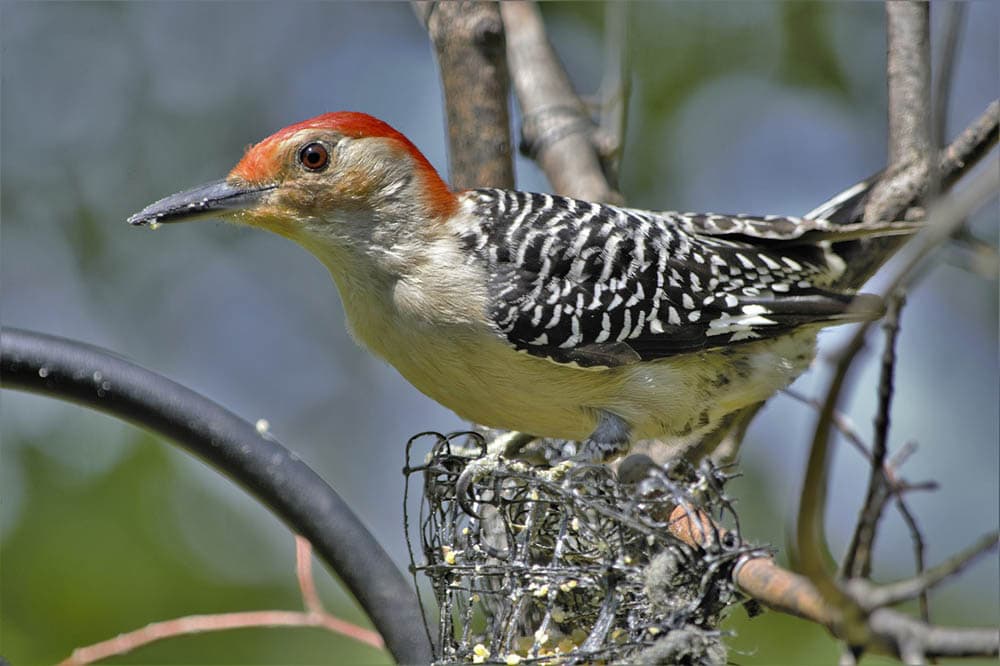
| Length | 9.4 inches |
| Weight | 2.0-3.2 oz |
| Wingspan | 13.0 -16.5 in |
The Red-bellied woodpecker is of the family Picidae and is found throughout the eastern United States. In Oklahoma, their habitat ranges throughout most of the state but they aren’t common in the panhandle or further west. These birds are not considered migratory birds but there is some occasional movement from northern to southern areas of their habitat range during winter.
These medium-sized woodpeckers thrive in the woodlands but will also be observed in backyards with trees. Red-bellied woodpeckers tend to travel back and forth from the forest to residential areas to take advantage of bird feeders.
2. Red-headed Woodpecker
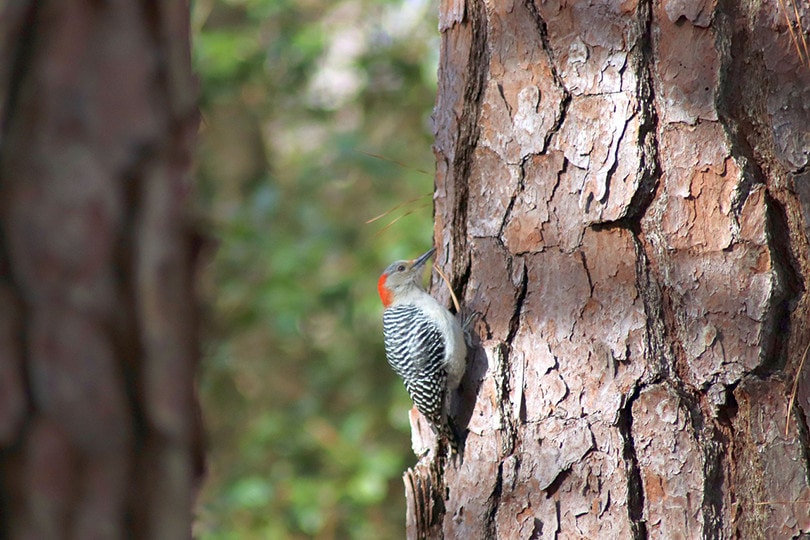
| Length | 7.5-9.1 inches |
| Weight | 2.0-3.2 oz |
| Wingspan | 16.5 inches |
Red-headed woodpeckers get their name from their bold and vibrant red head. This species is found year-round throughout the east-central United States and southern Canada. In Oklahoma, Red-headed woodpeckers are found throughout the entire state. Once a very common species of woodpecker, their numbers have recently begun decreasing due to habitat destruction.
These woodpeckers like the open woods, lower coastal plains, and swamps. They eat a varied diet of insects, earthworms, spiders, nuts, seeds, and berries. In the winter, these birds typically leave their northern and western ranges and head southeast.
3. Downy Woodpecker

| Length | 5.5-6.7 inches |
| Weight | 0.7-1 oz |
| Wingspan | 9.8-11.8 inches |
Downy woodpeckers are the smallest woodpecker species in North America. As adults, these birds reach about the size of a robin or a sparrow and their beaks are much shorter than your average woodpecker. Downy woodpeckers are found throughout Oklahoma all year round and stick to the forests and open woodlands.
They are very active in spring and summer and will commonly be spotted in parks and residential areas that are full of trees. In addition to tree hammering, Downy woodpeckers have very distinct high-pitched calls. In winter, they team up with other small species of birds in mixed flocks to increase their chances of finding food.
4. Hairy Woodpecker
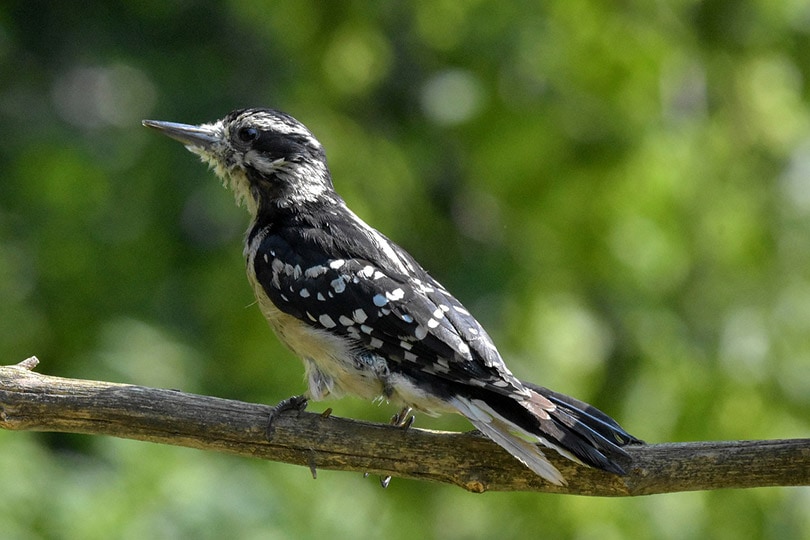
| Length | 7.1-10.2 inches |
| Weight | 1.4-3.4 oz |
| Wingspan | 13.0 -16 inches |
Hairy woodpeckers are a year-round species found throughout much of Oklahoma. Though slightly larger with longer bills, they are commonly mistaken for the downy woodpecker. These woodpeckers are most often observed on the main branches of trees or trunks.
This species can be found throughout most of North America. Those that live in the northern part of their habitat range tend to make their way south during the winter months.
5. Northern Flicker

| Length | 11-12.2 inches |
| Weight | 3.9-5.6 oz |
| Wingspan | 16.5-20.1 inches |
Northern flickers are a medium-sized, colorful woodpecker that is native to most of North America, parts of Central America, Cuba, and the Cayman Islands, and frequent a wide variety of habitats. They are one of the few woodpecker species that migrate.
Unlike most other woodpeckers, Northern flickers are typically observed foraging on the ground. Their diet consists primarily of ants and beetles. The species can be found year-round in Oklahoma in open woodlands and on the edges of forests.
6. Pileated Woodpecker

| Length | 15.8-19.3 inches |
| Weight | 8.8-12.3 oz |
| Wingspan | 26-29.5 inches |
Pileated woodpeckers are large woodpeckers that reach about the size of the American crow. Their range does not extend into the far western portions of Oklahoma but they do reside year-round in the eastern third of the state.
Pileated woodpeckers are not as commonly observed as some of the other woodpeckers on the list. They tend to stick to mature forests that are full of dead trees and downed wood. They loudly drum on the trees and make very distinct calls. These insectivores will excavate their holes and roost by themselves.
7. Red Cockaded Woodpecker

| Length | 7.9-9.1 inches |
| Weight | 1.5-1.8 oz |
| Wingspan | 14.2 inches |
The Red-cockaded woodpecker only inhabits a small portion of the southeastern United States and only comes up into the very far southeast corner of Oklahoma. They frequent dense, pine forests and will only nest or roost within the pines. This species is considered endangered and populations are dwindling quickly.
Red-cockaded woodpeckers can be quite difficult to find because of their low numbers and limited range. They will gravitate toward pine trees with heart fungus disease, which makes the wood softer and easier for excavating.
8. Ladder-backed Woodpecker

| Length | 6.3-7.1 inches |
| Weight | 0.7-1.7 oz |
| Wingspan | 13 inches |
Ladder-backed woodpeckers are a species found year-round over the southwestern United States and most of Mexico. They are only observed in the far western portion of Oklahoma and are most active from January to March during their breeding season.
These woodpeckers used to be known as cactus woodpeckers because they gravitated toward deserts and thorn forests that were filled with cacti. Most often, they will nest in dead trees and they feed mostly on insect larvae and the occasional adult insect.
9. Golden-fronted Woodpecker

| Length | 8.7-10.2 inches |
| Weight | 2.6-3.5 oz |
| Wingspan | 16.5 -17.3 inches |
The Golden-fronted woodpecker is native to Mexico and Central America where they are found year-round. They are sometimes found in the open woodlands and brushlands of central Texas up into part of southern Oklahoma, the only two states in the United States they are found.
This species feasts mainly on insects, seeds, and nuts but has been known to snatch up the eggs of other birds. They eat mainly insects, nuts, and seeds but will occasionally eat other birds’ eggs.
10. Yellow-bellied Sapsucker

| Length | 7.1-8.7 inches |
| Weight | 1.5-1.9 oz |
| Wingspan | 13.4 -15.8 inches |
The Yellow-bellied sapsuckers are found throughout the entire state of Oklahoma during the fall and winter months, typically from October through April. Once spring hits, they migrate north for their breeding season. Yellow-bellied woodpeckers nest throughout the northern United States and up into Canada.
They winter in open forests and create rows of sap wells for drinking, though they’ll also eat fruits, nuts, and insects. This species frequents young, deciduous forests in higher elevations during the nesting season.
11. Lewis’s Woodpecker
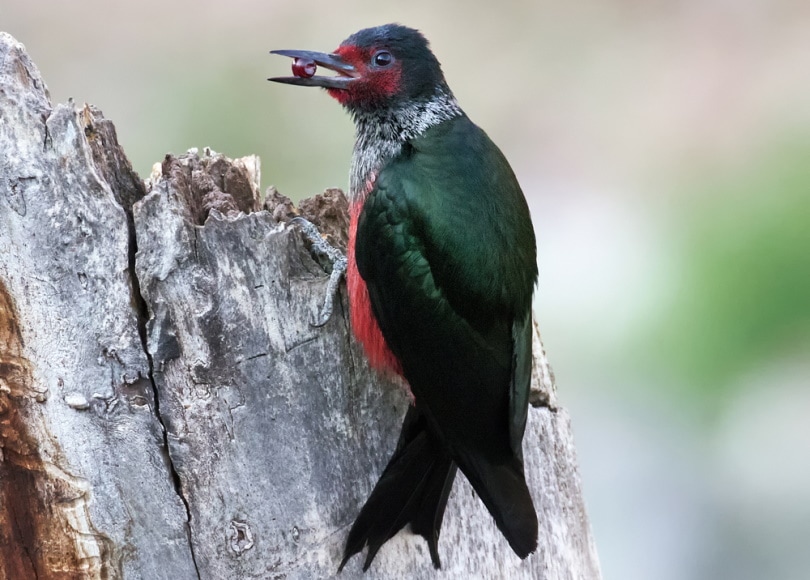
| Length | 10.2-11 inches |
| Weight | 3.1-4.9 oz |
| Wingspan | 19.3-20.5 inches |
Lewis’s woodpeckers aren’t a common species in Oklahoma and are typically only observed in the far west portion of the Panhandle. Their range is only from western to the central United States but they have wintered as far south as the Mexico border and extend up into southwestern Canada in the summer.
The Lewis’s Woodpecker is unique in that it feeds by catching insects mid-air. It will feed on insects, fruits, and nuts but as winter approaches they put their focus on foraging for acorns and nuts for storage throughout the season.

Conclusion
There may be 11 different species of woodpecker in the Sooner State, you will be more likely to encounter some of them than others. While Oklahoma has quite a few year-round species that are found throughout most of the state, some species only visit small portions of Oklahoma during certain seasons.
Featured Image Credit: Warren Price Photography, Shutterstock
Table of Contents
About the Author Robert Sparks
Robert’s obsession with all things optical started early in life, when his optician father would bring home prototypes for Robert to play with. Nowadays, Robert is dedicated to helping others find the right optics for their needs. His hobbies include astronomy, astrophysics, and model building. Originally from Newark, NJ, he resides in Santa Fe, New Mexico, where the nighttime skies are filled with glittering stars.
Related Articles:
Monocular vs Telescope: Differences Explained (With Pictures)
10 Types of Hummingbirds in Arkansas (With Pictures)
8 Types of Hummingbirds in Nebraska (With Pictures)
5 Types of Hummingbirds in Idaho (With Pictures)
3 Types of Hummingbirds in Mississippi (With Pictures)
8 Types of Hummingbirds in Kansas (With Pictures)
5 Types of Hummingbirds in West Virginia (With Pictures)
5 Types of Hummingbirds in Ohio (With Pictures)
